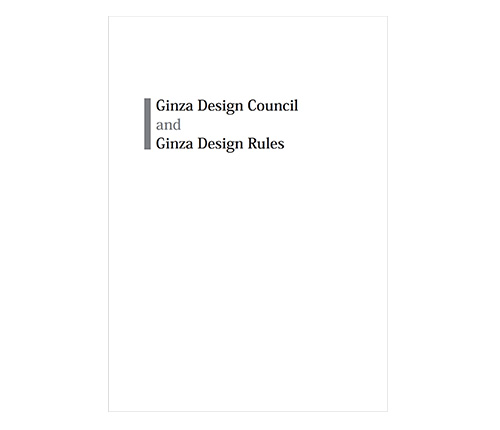Ginza Rules
In Ginza, people have always decided what to do with their district and what is Ginza-like by discussing what they want to do with their district. This spirit has been carried on unchanged from the Meiji period to the present.
The following district planning “Ginza Rules” and guidelines for the maintenance of parking facilities were established as ordinances by Chuo Ward, but these rules were also established through consultation and agreement between Chuo Ward and Ginza. We in Ginza believes that these “Ginza Rules” will continue to be studied, detailed, and updated in order to keep Ginza progressive as times change.
Ginza Design Rules
Ginza Design Rules – Third Edition

- Format: A4, full-color, 68 pages
- Production cost (printing and materials): ¥2,500 (plus shipping)
- Responsible Editors: Ginza Town Development Council and Ginza Design Council
- Cooperation: Chuo Ward
- Issued by: Ginza Association and the Ginza Street Association
- Date of Publication: February 1, 2021
The “Ginza Design Rules” are a set of guidelines that evolve flexibly in response to Ginza’s urban experience and changes in social conditions. The first edition, published in 2008 following two years of work by the Ginza Design Council, was updated with a second edition in 2011 and a supplementary second edition in 2015.
The third edition, published in 2021, has been developed to address a wide range of issues—from streetscape and traffic to commerce, culture, inbound tourism, and international promotion—reflecting the increasingly multifaceted challenges facing Ginza today. In this edition, the focus has shifted from “designing a streetscape that reflects Ginza’s character” to “designing an entire district that embodies Ginza’s essence.”
Ginza Design Rules – Third Edition Case Studies

- Format: A4, full-color, 28 pages
- Production cost (printing and materials): ¥1,500 (plus shipping
- Produced by: Kobayashi & Maki Design Workshop, Inc.
- Cooperation: Chuo Ward
- Issued by: Ginza Association and the Ginza Street Association
- Date of Publication: October 1, 2023
This case study booklet details qualitative criteria, discerned from the current street scapes—beyond words or numbers—for assessing the “Ginza-ness” of a project. They break down the urban environment into six human-centered scales, offering specific viewpoints and considerations.
The case study booklet includes abundant illustrations and interviews with internationally acclaimed graphic designers, architects, and business operators. Together, these resources are intended to help designers understand and incorporate the essence of Ginza from the outset of a project.
Rules for Digital Signage and Audio
In the commercial heart of Ginza, continuous innovation in expression and new trial initiatives have always been pursued. However, these efforts are balanced against the need to maintain harmony and continuity with the calm, established streetscape —ensuring that visitors enjoy an environment that is distinctly “Ginza.”
Because Ginza is organized around its main streets as public spaces, the quality of these spaces is paramount. Accordingly, advertising and promotional materials that do not align with Ginza’s brand are discouraged. When new advertising is planned, project operators are asked to consult with the All-Ginza Association’s Ginza Design Council to ensure that the content is appropriate and that it contributes positively to revitalizing Ginza.
In line with these objectives, guidelines regarding digital signage and accompanying audio have been established and disseminated.
Ginza Design Rules English

I. Ginza Design Council
I-i.Ginza: Area's Characteristics and Organization
I-ii.The Regulations Concerning Ginza
I-iii.The Unique Characteristics of Ginza Design Council
II. Ginza Design Rules
II-i.Contents of Ginza Design Rules
II-ii.Philosophies common to the entire design practice
Colors
Sense of Scale
Height
Materials
Illumination
Designs that uniquely fits Ginza
Thorough discussions
Harmony and cooperation with neighbors
Designs considering local characteristics
Businesses and purposes
Management of a building after its completion
II-iii.About Digital Signage
III. Summary